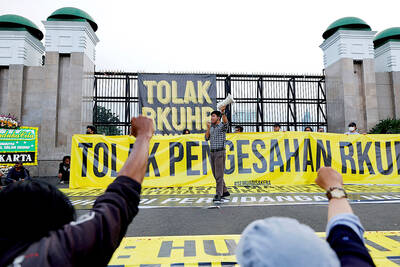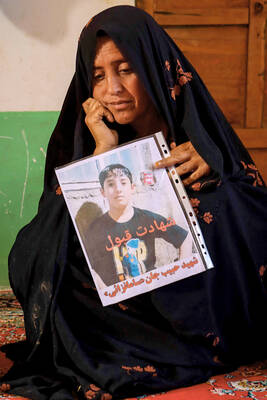Chinese President Xi Jinping (習近平) formally reorganized the People’s Liberation Army (PLA) under five “battle zones,” securing the last major piece expected in China’s biggest military overhaul in decades.
Xi, who also serves as commander-in-chief, presided over a ceremony at the Ministry of National Defense in Beijing on Monday to formally convey banners to generals in charge of the new zones, Xinhua news agency said.
The areas — northern, southern, eastern, western and central — replace seven military regions and unify the branches under a single command structure for the first time. The new commanders and political commissars for the five zones were also announced, Xinhua said.

Photo: AP
The regional rezoning was the last major component of a shakeup first floated by Xi more than two years ago and intended to make the world’s largest army better equipped to project force beyond the country’s borders. The overhaul comes at a time when China has become more assertive about its territorial claims over the East China Sea and South China Sea, raising tension with its neighbors and the US.
“It is designed to streamline command-and-control functions and organizationally restructure the PLA into a military better able to wage war in the information age and make it more accountable to the party,” said Andrew Scobell, a senior political scientist at RAND Corp. “It remains to be seen how successful the reforms will be and how long the reorganization will take.”
The creation of the battle zones “marks a strategic decision made by the party central leadership and the Central Military Commission with the aim of realizing the Chinese dream and the strong-army dream,” Xi said, according to Xinhua.
“All battle zones must unwaveringly listen to the party’s direction, insist upon the party’s absolute leadership,” Xi said.
Defense ministry spokesman Yang Yujun (楊宇軍) said in a separate statement posted online that China would maintain its “defensive national defence policy” and that the country’s development and foreign policy would be unchanged
Bloomberg first reported details of the plan in September last year, days before Xi announced the reorganization during a parade to commemorate the 70th anniversary of Japan’s surrender in World War II.
The plan calls for reducing the 2.3 million-member PLA by 300,000 and redefining missions and responsibilities among the military branches, with the goal of building a fighting force that “can win modern wars.”
“The reforms will also increase CCP [Chinese Communist Party] control over the military, and Xi Jinping’s personal control as chairman of the Central Military Commission,” said Phillip Saunders, director of the Center for the Study of Chinese Military Affairs at the National Defense University in Washington. “The reform is bigger than I expected, and will be disruptive to the PLA until it is fully implemented, probably by 2020.”
The overhaul has been rolled out in recent months, including Xi’s announcement on Sept. 3 last year of the overhaul and troop reduction and the establishment on Nov. 26 of a joint military command that brought all branches of the armed forces under one roof.
Additional reporting by Reuters

Indonesia yesterday began enforcing its newly ratified penal code, replacing a Dutch-era criminal law that had governed the country for more than 80 years and marking a major shift in its legal landscape. Since proclaiming independence in 1945, the Southeast Asian country had continued to operate under a colonial framework widely criticized as outdated and misaligned with Indonesia’s social values. Efforts to revise the code stalled for decades as lawmakers debated how to balance human rights, religious norms and local traditions in the world’s most populous Muslim-majority nation. The 345-page Indonesian Penal Code, known as the KUHP, was passed in 2022. It

‘DISRESPECTFUL’: Katie Miller, the wife of Trump’s most influential adviser, drew ire by posting an image of Greenland in the colors of the US flag, captioning it ‘SOON’ US President Donald Trump on Sunday doubled down on his claim that Greenland should become part of the US, despite calls by the Danish prime minister to stop “threatening” the territory. Washington’s military intervention in Venezuela has reignited fears for Greenland, which Trump has repeatedly said he wants to annex, given its strategic location in the arctic. While aboard Air Force One en route to Washington, Trump reiterated the goal. “We need Greenland from the standpoint of national security, and Denmark is not going to be able to do it,” he said in response to a reporter’s question. “We’ll worry about Greenland in

PERILOUS JOURNEY: Over just a matter of days last month, about 1,600 Afghans who were at risk of perishing due to the cold weather were rescued in the mountains Habibullah set off from his home in western Afghanistan determined to find work in Iran, only for the 15-year-old to freeze to death while walking across the mountainous frontier. “He was forced to go, to bring food for the family,” his mother, Mah Jan, said at her mud home in Ghunjan village. “We have no food to eat, we have no clothes to wear. The house in which I live has no electricity, no water. I have no proper window, nothing to burn for heating,” she added, clutching a photograph of her son. Habibullah was one of at least 18 migrants who died

Russia early yesterday bombarded Ukraine, killing two people in the Kyiv region, authorities said on the eve of a diplomatic summit in France. A nationwide siren was issued just after midnight, while Ukraine’s military said air defenses were operating in several places. In the capital, a private medical facility caught fire as a result of the Russian strikes, killing one person and wounding three others, the State Emergency Service of Kyiv said. It released images of rescuers removing people on stretchers from a gutted building. Another pre-dawn attack on the neighboring city of Fastiv killed one man in his 70s, Kyiv Governor Mykola